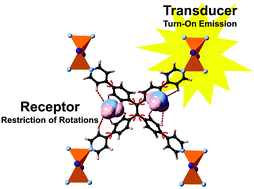Luminescence turn-on detection by an entanglement-protected MOF operating via a divided receptor–transducer protocol†
Abstract
Here it is demonstrated that the tetraphenylethene moiety, a typical AIE luminogen, can act as a receptor instead of a transducer in a MOF to enable turn-on ammonia detection. The CuI-based MOF, normally vulnerable to ammonia attack, is protected by network entanglement and shows good stability, selectivity and recyclability. Moreover, it is demonstrated that the AIE phenomenon usually active in solution is also valid at the solid–liquid interface, and the AIEgen works even better in a MOF than in solution for calibrating solvent viscosity with a favorable linear response.



 Please wait while we load your content...
Please wait while we load your content...